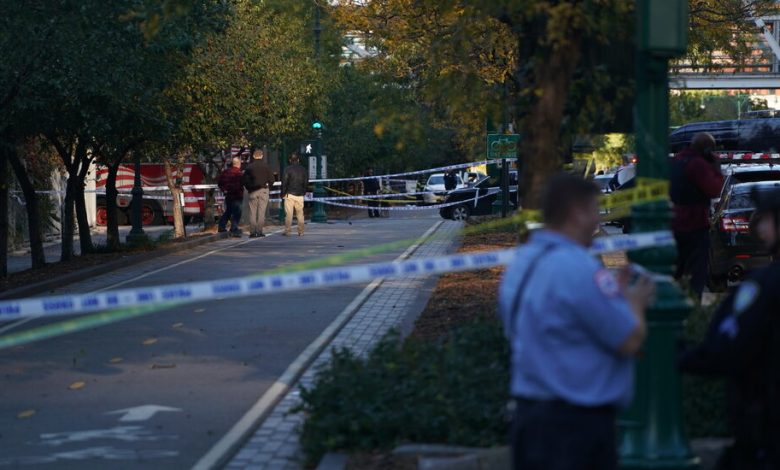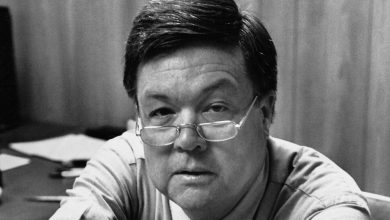Bike-Path Terror Defendant Is Too Dangerous for Prison, Prosecutors Say

A federal prosecutor told a Manhattan jury on Monday that Sayfullo Saipov, who drove a truck down a crowded West Side bike path in 2017, mowing down eight people without mercy in a terrorist attack, had “not abandoned his jihad, his fight.”
The prosecutor, Amanda Houle, said Mr. Saipov had shown no remorse and was still committed to the Islamic State, a terrorist group whose violent martyrdom videos he had consumed on his phone. Even his arrest, she said, did not stop Mr. Saipov’s threats, including one to slit the throat of a corrections officer.
“He is dangerous even in prison,” Ms. Houle said. “So the United States is seeking the most severe penalty that the law provides — a sentence of death.”
Ms. Houle’s presentation opened an uncommon death penalty hearing in Manhattan as prosecutors are seeking to persuade the jury to impose capital punishment on Mr. Saipov. On Jan. 26, after a trial of nearly three weeks, the same jury found Mr. Saipov guilty of each of the 28 counts he faced.
They included eight counts of murder in aid of racketeering activity — one for each of the eight fatalities — and one count of violence and destruction of a motor vehicle causing death. These nine counts each carry a maximum sentence of life imprisonment or execution.
Mr. Saipov was also convicted of providing material support to a terrorist organization, ISIS, which carries a maximum sentence of life in prison, and 18 attempted murder counts.
Death penalty trials in New York are rare and the actual imposition of the ultimate punishment is even rarer: The last execution in the state was in 1963. Mr. Saipov’s case is also notable because he is the first defendant to face a federal death penalty trial during the administration of President Biden, who had campaigned against capital punishment.
On Monday, David M. Stern, a lawyer for Mr. Saipov, a 35-year-old native of Uzbekistan, acknowledged to the jury that his client had done “a terrible, terrible thing” when he unleashed mayhem in Manhattan that Halloween. But he said the jury would hear from Mr. Saipov’s relatives, who would describe his upbringing in a close-knit family. He showed the jury photos of Mr. Saipov as a child with his family, and other photos, of his own children. Mr. Saipov’s past, he said, “could not have predicted his present.”
Mr. Stern urged jurors to reject the government’s argument for Mr. Saipov’s execution, saying the “cycle of death has to stop somewhere.” He noted that whatever the jury decided, Mr. Saipov would end his life either on an execution chamber’s gurney or isolated in a cell in a “harsh and impregnable prison in the middle of nowhere.”
Understand the Bike-Path Terror Trial
A high-profile case. Sayfullo Saipov was found guilty of driving a truck onto a Manhattan bike path and killing eight people on Halloween Day in 2017 — an attack that was the deadliest terrorist attack in New York City since Sept. 11 according to the authorities. Here is what to know:
How did the attack unfold? Prosecutors say that Mr. Saipov plowed a rented pickup truck down a bike path along the Hudson River, killing eight and injuring 11. The rampage ended when he smashed into a school bus, jumped out of the truck and ran down the highway shouting “God is great” in Arabic. A police officer shot him in the abdomen, bringing him down.
Who were the victims? Of the eight fatalities, six were tourists, five from Argentina and one from Belgium. The other victims were a 23-year-old computer scientist from Manhattan and a 32-year-old financial worker from New Jersey.
What do we know about Mr. Saipov? Mr. Saipov is an Uzbek immigrant; he left his home country in 2010 after winning the U.S. visa lottery. He told the authorities after he was arrested that he was inspired to carry out the attack by Islamic State videos and that he had used a truck as a weapon in order to inflict maximum damage against civilians.
What was Mr. Saipov charged with? Mr. Saipov faced charges that include murder, attempted murder, providing material support to a foreign terrorist organization and violence and destruction of a motor vehicle. He was convicted of all counts on Jan. 26; a jury will now decide whether he should be executed or receive life imprisonment, for which a unanimous vote is required.
Why is the outcome of the trial significant? Mr. Saipov, who was charged during the Trump administration and pleaded not guilty, is the first person to face a death penalty trial during the administration of President Biden, who had campaigned against capital punishment. Mr. Saipov’s lawyers asked the Justice Department to reconsider, but Attorney General Merrick B. Garland denied their request.
“His death in prison is certain,” Mr. Stern said. “Only the time and cause of death remain to be determined.”
The judge, Vernon S. Broderick, told the jury on Monday that the hearing essentially amounted to a second trial, with both the government and the defense each putting forth evidence and testimony in favor of or against capital punishment.
“It is impossible for me to overstate the importance of the decision before you,” Judge Broderick said, “or the careful and thorough consideration you should give to this matter.”
Outside the presence of the jurors, Judge Broderick asked the lawyers and prosecutors about a torrent of news reports Monday about a man driving a U-Haul truck who was arrested after careening onto Brooklyn sidewalks and hitting pedestrians, injuring at least eight.
Keechant L. Sewell, the city police commissioner, said no terrorism link had been found, but the incident had eerie echoes of Mr. Saipov’s attack.
The judge said he wanted to know how best to advise the jury, given the news reports. David E. Patton, another of Mr. Saipov’s lawyers, said the defense moved for a mistrial.
Judge Broderick said that was “premature at best” and denied it, in part because he said there was “no factual connection at all” between Mr. Saipov’s case and the Brooklyn incident.
During Mr. Saipov’s trial, the jury heard evidence that he drove a rented pickup truck across the George Washington Bridge into Manhattan on Oct. 31, 2017, then turned onto the bike path and sped south, smashing into cyclists before crashing into a school bus.
It was the deadliest terrorist attack in New York City since Sept. 11, 2001, the authorities have said.
Mr. Saipov jumped out of the truck, waving pellet and paintball guns and shouting “Allahu akbar,” Arabic for “God is great.” He was arrested after being shot in the abdomen by a police officer. At Bellevue Hospital Center, where Mr. Saipov where Mr. Saipov was treated, he asked an F.B.I. agent if he could hang the ISIS flag in his hospital room, the agent testified at the trial.
Mr. Saipov also said he wanted to strike and kill as many people as possible, the agent said.
Witnesses testified that as Mr. Saipov plowed into bicyclists, he sent riders into the air, crushed others on the ground and left behind a scene of devastation, of mangled bicycles and scattered bodies.
The dead included six tourists, five from Argentina and one from Belgium. The two other victims were a 23-year-old software engineer from Manhattan and a 32-year-old financial worker from New Jersey.
Prosecutors have said they will present testimony from more than 20 relatives of those killed and victims who survived the attack.
Ana Evans, the first witness to testify on Monday afternoon, was the widow of one of the Argentine victims, Hernan Mendoza.
Speaking through an interpreter, Ms. Evans said she and her husband “made a very good team — we complemented each other very well.” She recalled fondly how they first met and the day their youngest daughter was born.
Ms. Evans told the jury she had heard from her husband on the day of the attack. He had sent her an audio message from a Manhattan market the Argentine group was visiting.
Soon, she said, she learned about the attack from a call, and she described the difficulty of explaining to her three children, then 3, 9 and 11, that their father had died.
“Daddy. That’s daddy,” Ms. Evans recalled her youngest daughter exclaim as coverage of the attack played on the television. The small child, standing on her toes, placed her palm on the screen where her father’s image had appeared, Ms. Evans said.
“The scars of what happened are still there,” she testified. “I don’t know how to stop feeling his absence.”
Another witness, Rachel Pharn, who was biking north on the path, testified that she saw the truck run over two cyclists in front of her — and then it struck her, too. She suffered a broken foot and ankle and damage to her left shoulder, she said.
Ms. Pharn, who said she has been in talk therapy and received medication to cope, said she has had flashbacks of what happened that day almost every day since.
“While the last few years have been the most transformative and positive growth I’ve ever experienced,” she said, “at other times, it’s been hard to find the will to live.”




